based on E.H. Nickel & M.C. Nichols (2009), H. Strunz & E.H. Nickel (2001),
revised by Thomas Witzke (2023)
5. CARBONATES
(Carbonates, Nitrates)
5.B: Carbonates with additional anions, without water
Azurite: with CuO5 tetragonal pyramids.
 | 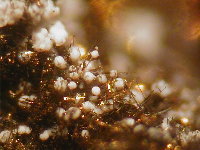 |  |  |
Hydrozincite: cations in tetrahedral and octahedral coordination. Layers of edge-sharing octahedra, every fourth octahedral position is not occupied. On the non-occupied positions to both sides of the layer a tetrahedra is placed.
Sclarite: framework of cations in tetrahedral and octahedral coordination. The octahedra share edges and corners (Grice & Dunn, 1989, Am. Min. 74, 1355-1359). Loseyite is isostructural.
 | 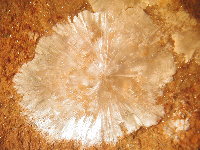 |  |  |
Holdawayite: a framework of edge- and corner-sharing octahedra. (Cl,OH) is situated in large tunnels running parallel b.
Dawsonite: AlO2(OH)4 octahedra and distorted NaO4(OH)2 octahedra (Frueh & Golightly, 1967, Can. Min. 9, 51-56).
Barentsite: layers of edge-sharing Al(O,F)6 octahedra and distorted Na(O,F)6 octahedra parallel (001), the layers are connected by distorted Na(O,F)6 octahedra.
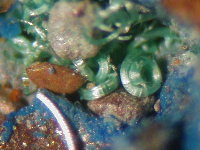 | 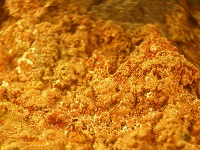 | 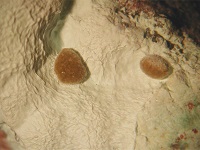 | 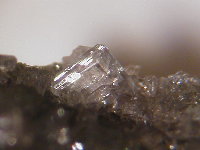 |
Malachite: with chains of edge-sharing CuO6 octahedra and CuO5 tetragonal pyramides.
Tunisite: layers of edge- and corner-sharing AlO6 octahedra, alternating with layers Ca in 10-fold coordination, Na(O4Cl) tetragonal pyramids and carbonate groups. The pyramides with apical chlorine point in the octahedral layer.
Sabinaite: Ti in octadedral, Zr in 7-fold (pentagonal dipyramides) and Na in 6- and 8-fold coordination.
Rouvilleite: Na in distorted octahedral and 7-fold coordination, Mn/Ca is in irregular 6- to 7-fold (distance 2.235 - 2.555 or 2.757 Å) and Ca in 7-fold coordination (Yamnova et al., 1991, Soviet Physics - Crystallography 36, 14-16).
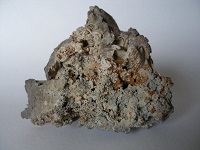 | 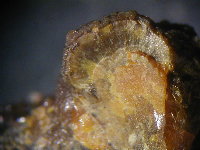 | 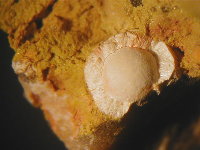 | 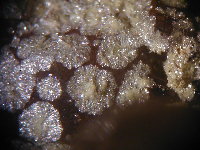 |
Shannonite: Pb in irregular 7-fold and 8-fold coordination. The coordination polyhedra are strongly distorted due to the effect of s2 lone electron pairs on the Pb2+ cations (Krivovichev & Burns, 2000, Min. Mag. 64, 1063-1068).
Grootfonteinite: the structure is formed by layered blocks composed of three sheets [PbCO3][PbO][PbCO3]. The composition of the [PbO] sheet is idealized, the real composition is [(Pb0.7Na0.3)(O0.7(OH)0.3]. The stereochemically active 6s2 lone electron pairs of the two Pb atoms are located in between the blocks, similar to the structure of litharge. Pb is in a 6 + 1 coordination with 6 oxygen (distance of ca. 2.7 Å) in an equatorial plane and one oxygen in a short bond (2.2 Å) perpendicular to one side of the plane, and in a 9-fold coordination around a split position, forming a tricapped trigonal prism. At the second position, a part of the Pb is replaced by Na. The structure is related to the structures of hydrocerussite and abellaite (Siidra et al., 2018, Eur. J. Min. 30, 383-391).
Hydrocerussite: the structure is formed by layered blocks composed of three sheets [PbCO3][Pb(OH)2][PbCO3] (Siidra et al., 2018, Eur. J. Min. 30, 383-391).
Somersetite: layered structure of alternating blocks of electroneutral plumbonacrite-type [Pb5O(OH)2(CO3)3] and hydrocerussite-type [Pb3(OH)2(CO3)2], separated by stereochemically active lone electron pairs on Pb2+ (Siidra et al., 2018, Min. Mag.).
Abellait: the structure is formed by layered blocks composed of three sheets [PbCO3][Na(OH)][PbCO3] (Ibáñez-Insa et al., 2017, Eur. J. Min 10; Siidra et al., 2018, Eur. J. Min. 30, 383-391).
Phosgenite: Pb in 4 O + 5 Cl coordination, forming a strongly deformed monocapped square antiprism. The Pb-O bond lengths showing an average of 2.598 Å and the Pb-Cl of 3.160 Å (Giuseppetti & Tadini, 1974, Tscherm. Min. Petr. Mitt. 21, 101-109).
Bismutite: layered structure with alternating Bi-O and carbonate layers. Bi(1) in 8-fold (4 + 4) coordination, forming a square antiprism compressed along [001], with bond lenghts around 2.4 Å and 2.842 Å. The compression and the unequal bond-lengths are a consequence of the stereoactive lonepair of electrons associated with Bi3+ ions. Bi(2) has also 8-fold coordination, in a truncated tetrasphenoid. The bond lenghts are shorter (2.23 and 2.67 Å), indicating that the stereoactive lone-pair of electrons are more involved in bonding (Grice, 2002, Can. Min. 40, 693-698).
Kettnerite: layered structure with a sequence of Bi-O, carbonate, CaF, carbonate layers. The structure is related to the bismutite structure.
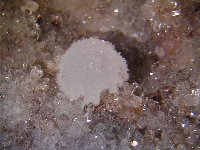 | 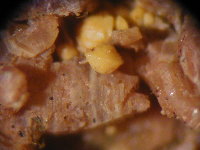 | 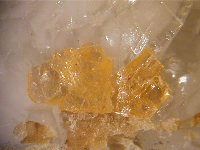 | 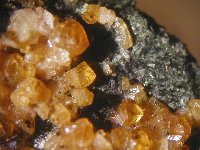 |
Brenkite: Ca in irregular coordination with four F and three O, with average Ca-F distances of 2.388 Å and Ca-O distances of 2.426 Å (Leufer & Tillmanns, 1980, Tschermaks min. petr. Mitt. 27, 261-266).
Podlesnoite: the structure shows a honeycomb-like framework of columns of edge-sharing CaO6F2 polyhedra stretched parallel to the c axis. Distances of Ca to O/F ranging from 2.2912 to 2.4883 Å. Ba is in 10-fold coordination and forms BaO6F4 polyhedra (distances Ba to O/F from 2.771 to 2.915(2) Å. The CO3 groups are oriented parallel to the ac plane. The structure is slightly related to aragonite (Zubkova et al., 2009, Z. Krist. 222).
Arisite: Na in 6-fold (trigonal prism), REE in 10-fold (9 O + 1 F) coordination.
Cordylite: (Na/Ca) in 6-fold (trigonal prism), REE in 10-fold and Ba in 12-fold (hexagonal prism) coordination.
Horváthite-(Y): with NaO3F4 and YO4F4 polyhedra (Grice & Chao, 1997, Can. Min. 35, 743-749).
Bastnäsite: the structure is composed of (CeF) and (CO3) layers parallel (0001) in a ratio 1 : 1. Ce is coordinated in CeO6F3 polyhedra with three Ce-F bonds within the (CeF) layer (2.403 - 2.4157 Å) and six bonds to O of the carbonate groups (2.542 - 2.591 Å distance) (Ni et al., 1993, Am. Min. 78, 415-418).
The structures of Parisite, Synchysite and Röntgenite are based on the Bastnäsite structure. Additionally to the (CeF) and (CO3) layers, (Ca) layers are present, with different ratios of the three layers. The minerals form a polysomatic series with the general formula [REE(CO3)F]m [CaREE(CO3)2F]n, with Bastnäsite m=1, n=0, Parisite m=1, n=1, Röntgenite m=1, n=2 and Synchysite m=0, n=1.
Ca is in 8-fold coordination (2.34 - 2.85 Å distance). Different polytypes are possible (Ni et al., 2000, Am. Min. 85, 251-258).
Qaqarssukite-(Ce) has a layered structure related to that of Synchysite-(Ce), composed of three chemically distinct layers parallel to (0001): (1) carbonate groups oriented perpendicular to the layering, (2) a layer of Ce-O-F polyhedra, and (3) a layer of Ba-O-F polyhedra. Ce is coordinated in CeO6F3 polyhedra, Ba in BaO9F and BaO12 polyhedra (Grice et al., 2006, Can. Min. 44, 1137-1146).
Huanghoite-(Ce): with CeO9F polyhedra forming layers perpendicular to (001).
Kukharenkoite: Ba in 10-fold coordination (7 x O and 3 x F with distances Ba to O/F ranging from 2.717 to 2.875 Å) and in 11-fold (or 10 + 1) coordination with O with distances 2.659 and 2.835 to 2.984 Å. REE in 10-fold coordination (9 x O and 1 x F) with distances of the central atom to O/F 2.434 to 2.738 Å. The structure can also be described as having F-centered [FCeBa3] tetrahedra, linked through shared edges to form double chains [FCeBa] along the b axis (Krivovichev et al., 1998, Can. Min. 36, 809-815).
Cebaite-(Ce): with CeO9F polyhedra forming double infinite chains.
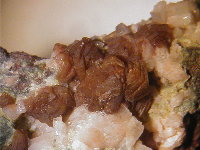 | 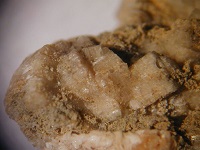 | 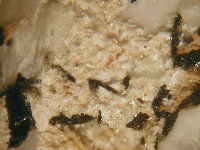 |  |
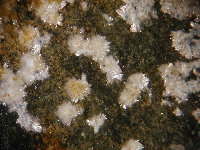 | 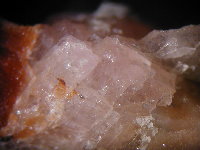 | 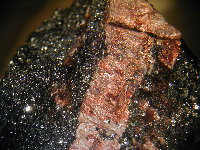 |  |
G = Grandfathered minerals: original description preceded the establishment of the CNMNC in 1959, and generally regarded as a valid species
A or IMA No. = Minerals approved by the CNMNC
Rd = Redefinition of the mineral approved by the CNMNC
Rn = Renamed with approval by the CNMNC
Q = Questionable mineral
Classification principles:
Subdivision of the Carbonates subclass "5.B: Carbonates with additional anions, without water" completely re-arranged compared to the chemical classification in Strunz 9. The subdivision is based now on structural aspects, the coordination polyhedra, corresponding roughly to the cation size (from smaller to larger cations): 5.BA. With cations only in tetrahedral [4] or only in tetragonal pyramidal [5] coordination; 4.BB. With cations in tetrahedral + other coordination; 5.BC. With cations only in octahedral coordination; 5.BD. With cations in octahedral + other coordination; 5.BE. With cations in 7- to 9-fold coordination: cations (Pb, Bi) with stereochemically active lone electron pairs; 5.BF. With cations (Ca, Ba, REE) in 7- to 12-fold coordination to O and F; 5.BG. Carbonates with additional tetrahedral anions: SO4, PO4, SiO4.
Further classification:
|
5.BA. With cations only in tetrahedral [4] or only in tetragonal pyramidal [5] coordination: Only one mineral. 5.BB. With cations in tetrahedral + other coordination: With cations in tetrahedral and octahedral coordination, only 2 groups. 5.BC. With cations only in octahedral coordination: Mainly medium-sized cations in octahedral coordination; large cations in octahedral coordination. 5.BD. With cations in octahedral + other coordination: Medium-sized cations in octahedral + other cations in other coordination sorted according to increasing coordination number; large cations in octahedral + other cations in other coordination. 5.BE. With cations in 7- to 9-fold coordination: cations (Pb, Bi) with stereochemically active lone electron pairs: Pb carbonates; Bi carbonates. 5.BF. With cations (Na, Ca, Ba, REE) in 6- to 12-fold coordination to O and F: Single coordination type, arranged with increasing coordination number; more than one coordination type, arranged with increasing coordination number. Exception: Bastnäsite group placed next to the Synchysite group because of the close structural relation. 5.BG. Carbonates with additional tetrahedral anions: SO4, PO4, SiO4: Carbonates with additional SO4; with PO4; with SiO4. |
To distinguish from classical Strunz numbering, on hierarchical "group" level, a numbering with 3 digits is used, like "5.BA.005. Azurite", instead of 2 digits (like "5.BA.05.") in the Strunz system.
© Thomas Witzke (2023)
